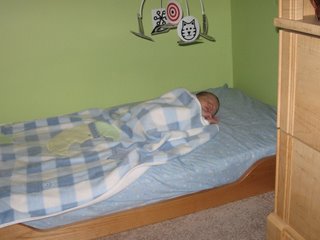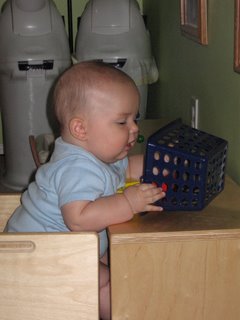Though we haven't yet prepared any real lessons for Alex, a friend with an older baby asked how Montessori might be implemented in the home. What follows is a basic overview of the Montessori method for delivering an individual lesson.Montessori made two discoveries in her early work with children that translated into a method for delivering "lessons." First, she realized that adult materials were not suitable for children. She was a pioneer in the development of child-sized furniture, tools, and materials. Fortunately, today, these are fairly easy to obtain. For a great resource in this respect, check out http://michaelolaf.com or http://www.forsmallhands.com.
Montessori's other discovery was that adults do not often take the time to slowly and carefully present movements or activities to children. Therefore, her presentations took on a very deliberate, explicit nature that she called "using analyzed movements."
Thus, in essence, a "Montessori lesson" that might be implemented in the home involves demonstrating a task using analyzed movements and appropriate, child-sized materials. (It seems important to note here that these are not the only types of lessons given in a Montessori classroom, but that these are probably the most appropriate to life in the home)
PreparationTo prepare an activity, then, you would first want to gather and arrange all the materials a child will need to complete that activity. To help a child know which items belong to a single activity, you might color-coordinate them or put them all on one tray. Think about where this activity will be kept in the home so that a child can get it himself and put it away when he's finished.
Example: For banana slicing, I might put together a tray with an underlay, a small cutting board, a plate, a knife, a paper towel for waste, toothpicks to insert into the slices, and a sponge for cleaning. The tray might sit on a shelf in the kitchen, and the child would know it was available for use if there was a banana on the plate.
Once you have all your materials, practice your presentation on your own. You'll want to think about each discrete step of the activity and use slow, precise movements. You may discover that a given movement we adults do with ease is too difficult (for example, turning over a bottle cap in one hand). You'll also discover that there are a million choices to consider. Make sure you have your presentation down before you give it to the child, because once her mental camera is rolling, it is very difficult to rewind and "erase" mistakes or make changes to the way you want something done.
Example: When she sits down with the tray, where do I want her to put the cutting board? How will she handle the initial peeling? What will she do with the peel when she's done? How should she hold the knife? Where should the knife go when she's done slicing? Should she clean up before or after eating the snack? Note: The purpose of perfecting a presentation isn't so that the child will copy you exactly or demonstrate perfection herself; it is so that she gets a very clear, hesitation-free demonstration of one way to accomplish a particular task.
Presentation Engagement:
-A parent might approach her child when he's not busy and say something like "Alex, I have something I'd like to show you. Come with me to the [place where the activity is]."
-When they get to the shelf/place where the activity "lives," the parent might say "This is banana slicing. You can carry the tray like this (
demonstrates lifting the tray and putting it back). Let's take it to your table (
allows the child to lift and carry it to the table)."
Work:
-The parent might sit beside the child to his right (if right-handed) on a low stool. She might begin by saying "Let me show you what we do with this." From this point forward with a young child, there will be little or no talking, as she wants the child to focus on her hands, not her mouth.
-The parent will give the entire sequence of the presentation (which hopefully will be short for a young child). For banana slicing, this might involve setting out each of the items on the tray in a particular arrangement on the table, lifting the banana onto the cutting board, lifting the knife, demonstrating how to correctly position one hand on the knife and one hand on the banana, slicing the top of the peel, carefully setting down the knife, peeling the banana, placing the peel on the paper towel, picking up the knife and again demonstrating hand position, slowly and carefully demonstrating cutting, setting down the knife, demonstrating toothpicking banana slices and putting them on a plate, folding the paper towel and throwing away the peel, wetting the sponge and wiping off the cutting board and knife, and setting the plate of bananas on a serving table.
-The parent would then get the necessary materials (banana, plate and paper towel in this case) to set everything up on the tray for the child to do and say "Now you can slice a banana."
-As the child gets going, the parent should slowly and unobtrusively get up from the stool, leave the child to his work, but remain close by to observe. This is important because there's a temptation for the child to ask for help if you're right there or for you to correct or get involved unnecessarily. If you are a little ways away, the child is independent, but can seek you if he really gets stuck. Note that if a child finds a "creative" way of accomplishing the same task you just demonstrated, this is fine as long as it is safe and within the bounds of appropriate use of the materials (i.e. You might stop him from waving a knife around, but you might not stop him from slicing before peeling and peeling each individual piece afterward.)
-If the cycle of activity is something that can be repeated, you can encourage this repetition after one cycle or at the transfer point by saying something like "You can wash the table as many times as you want."
Putting Away:
-When you recognize that the child is finished, swoop back in and ask "Are you finished?" If there is more to putting away than you've demonstrated already, say "Let me show you what we do next" and demonstrate. Otherwise, you might simply say, "Do you remember where this goes on the shelf?"
-Once it's all done, you might say "Now you can slice a banana whenever you want/whenever you see one on the tray."
Corrections and RepresentationsIf there were things that didn't go perfectly during the child's first attempt, you can give "points of interest" during later attempts or even ask for a turn to re-demonstrate something. This is always done without drawing attention to "mistakes." You might say, "I wonder if you could do that without spilling any water on the floor?" as a sort of challenge or you could say, "Could I take a turn?"
If you get into a presentation and realize you weren't as prepared as you thought or you are missing something, it's perfectly okay to say to stop, let the child know you are not ready, and suggest that you do it together later.
 I plopped Alex down next to it after a nap and feeding. At first, he was fascinated with the basket itself. He pulled its handles and untied the cloth interior. Eventually, he discovered that he could take objects out of the basket. He began exploring them one at a time, dropping them to the side when he was finished. Occasionally, one on the mat beside him would catch his eye and he'd give it another go.
I plopped Alex down next to it after a nap and feeding. At first, he was fascinated with the basket itself. He pulled its handles and untied the cloth interior. Eventually, he discovered that he could take objects out of the basket. He began exploring them one at a time, dropping them to the side when he was finished. Occasionally, one on the mat beside him would catch his eye and he'd give it another go.

